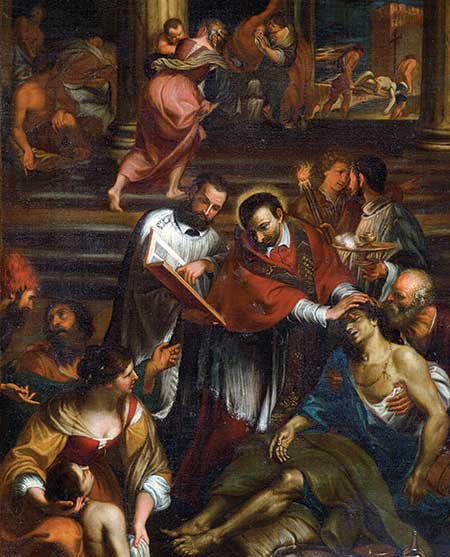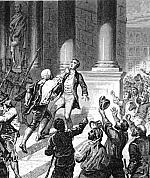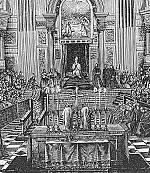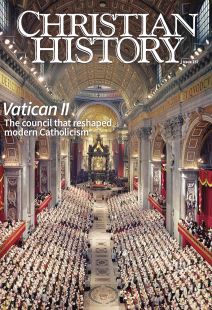Piety and power

[Giuseppe Bonati, Saint Charles of Borromeo among Plague Victims. 1740. Oil on canvas—Slovak National Gallery / Public domain, Wikimedia]
The Catholic Church emerged from the Reformation smaller in size but with renewed confidence and energy. Thanks to the reforms of the Council of Trent (1545–1563), Catholic bishops took their spiritual responsibilities more seriously and priests now had better training and a stronger sense of mission. The new Jesuit order rivaled the older Franciscans and Dominicans in both missionary zeal and intellectual prowess. Spanish mystics such as Teresa of Avila (1515–1582) and John of the Cross (1542–1591) built on rich traditions of medieval mysticism, while the practical advice of Francis de Sales (1567–1622) offered laypeople ways to live out their faith. Catholic art and music, also newly reformed, provided a way to know God through beauty (see CH #122).
These reforms throughout the late sixteenth and seventeenth centuries slowed the spread of Protestantism and even regained lost ground. Poland, Bohemia, and Hungary, on the verge of turning Protestant during the early Reformation, all swung decisively back toward Catholicism. Germany remained permanently divided between Protestants and Catholics, and the position of Holy Roman Emperor remained in the hands of the devoutly Catholic Hapsburgs. France, birthplace of John Calvin (1509–1564) and home to fervent Protestants, ultimately remained Catholic and officially ended the legal toleration of Protestantism in 1685.
The church won these victories through a close relationship with Catholic monarchs, often called the “throne and altar” alliance (see p. 11). Such an alliance between church and political authorities went back, of course, to the time of Constantine (d. 337). But during the Middle Ages, the relationship was often contentious, with the church checking monarchical power and even claiming supremacy over monarchs. In the Reformation’s wake, church leaders could no longer afford to push authority claims. They needed Catholic monarchs on their side. Popes negotiated concordats with various rulers—treaties that granted rulers considerable authority over the church. These agreements varied throughout Europe.
The Hapsburg family, the sixteenth century’s dominant Catholic dynasty, ruled Spain, parts of Italy, the Netherlands, and large parts of central Europe, as well as much of the Americas. The Austrian branch of the Hapsburgs also had a lock on the prestigious title of Holy Roman Emperor, which made them the official heirs of Constantine and counterparts to the pope as leaders of the Christian world. In fact the threat of a Protestant being elected to this position helped spark the Thirty Years’ War (1618–1648). Hapsburg rulers in both Spain and Austria persecuted Protestants and waged holy wars against both Protestant and Muslim nations, representing an aggressive, militaristic vision of Catholicism. Within Spain itself it had been illegal to practice any religion except Catholic Christianity since the end of the fifteenth century. The Spanish Inquisition (1478–1834), controlled by the monarchy, enforced religious uniformity with persecution.
In Germany and Bohemia, the Holy Roman Emperors led their sprawling dominions into a war with Protestants in 1618. This Thirty Years’ War devastated Germany and caused Europeans to question the kind of religious policies that produced such bloodshed and destruction. Eventually the Hapsburgs had to accept a peace treaty that reaffirmed the right of local rulers to determine the religion of their territories and officially acknowledged Calvinist as well as Lutheran Protestantism. Nonetheless the Hapsburgs purged their hereditary Austrian territories of Protestantism and and reimposed Catholicism on Bohemia and Hungary. They presented themselves, right up to the First World War, as model Catholic monarchs.
France on its own
In Catholic France the national church functioned most independently of Rome. Many French Catholics adhered to what would later be called “Gallicanism,” the view that the church in France should govern its own affairs under the monarch’s authority. French Catholics tended to favor the late medieval ecclesiology of conciliarism, whereby ultimate authority rested not with the pope but with a council representing the whole church. Throughout the late sixteenth century, religious wars tore the country apart. Most notoriously, on St. Bartholomew’s Eve in 1572, an attempt to assassinate key Protestant leaders spiraled into a bloodbath fueled by Catholic preachers. After the Edict of Nantes in 1598, the king gave French Protestants (Huguenots) fortified cities in southern France as well as autonomy. But it would not last.
Cardinal Richelieu (1585–1642) played a key role in shaping French religion and politics during the seventeenth century along Gallican lines. While often portrayed as a scheming, cynical villain, and certainly ambitious and capable of great ruthlessness, Richelieu seems to have also been sincerely pious. He believed he served the church by advancing French interests. Richelieu opposed Hapsburg ambition because he thought that the Hapsburgs used Catholic faith as a pretense for their ambitions. (Of course, the same could be said of him.) He centralized authority in France and waged war on the Huguenots; but unlike his Hapsburg neighbors, he did not believe in direct coercion to force them to return to Catholicism. Rather he sought to build up the Catholic Church as an appealing alternative.
During the seventeenth century, French Catholicism instituted reforms that led to a more educated clergy and a more devout laity. Many Huguenots did convert, but many did not. In 1685 King Louis XIV revoked the Edict of Nantes and declared that Protestantism no longer existed in France, under the massively exaggerated pretext that most had converted voluntarily. Thousands of Huguenots fled; many others were forced to slave on galleys for refusing to renounce their faith. Louis’s persecution of the Huguenots represented the last major attempt to force religious uniformity. He did so in the interests of national unity as much as of Catholicism, but in Gallican France, the two were seen as identical.
No one expects the Roman Inquisition
The popes of the era approved of attempts to promote Catholicism through government power. Pope Gregory XIII publicly celebrated the Massacre of St. Bartholomew, though he may have done so based on French propaganda, unaware of the atrocities involved. Official Catholic doctrine continued to affirm, as in the later Middle Ages, that heretics deserved the death penalty as violators of baptismal vows and traitors to God. Some Catholic theologians as early as the late sixteenth century argued that those raised as Protestants should not be considered heretics in this sense, but most believed such people were still guilty if they refused to become Catholic after being presented with Catholicism.
The Roman Inquisition, established in 1542 under direct papal supervision to try heresy cases and other religious offenses, represented the most direct instrument of religious repression. The Inquisition only sentenced to death about 2 percent of those accused, but that still represents more than a thousand people. (The royally controlled Spanish Inquisition tried a much larger number of people with a similar proportion of death sentences, amounting to several thousand over nearly four centuries. Popes sometimes intervened to rebuke the Spaniards for being too ferocious or accusing someone of heresy on insufficient grounds.) For the most part, monarchs, not the pope, handled the job of using coercion to defend the church against perceived threats, as part of the often contentious but (from the church’s perspective) still indispensable throne and altar alliance.
The Council of Trent had sidestepped papal authority questions and emphasized the need for a renewed episcopacy; bishops should be faithful pastors living among their flock rather than at Rome, exercising authority over the church within their dioceses. Individual bishops, however, could not negotiate effectively with their monarchs. Hence Trent’s vision was never fully realized, and papal authority grew rather than shrank. For example Charles Borromeo, model bishop of the Catholic Reformation (archbishop of Milan, 1564–1584), often came into conflict with the Spanish government; Pope Gregory XIII, who did not want to offend Philip II (1527–1598), did not fully support Borromeo in these conflicts.
Ironically in France, where the monarchy controlled the church and often defied Rome, the council’s vision took perhaps its fullest shape. Over the seventeenth century, the educational level and piety of French clergy increased dramatically. Gallican Catholicism, somewhat like its schismatic Anglican cousin across the Channel, emphasized the study of Scripture and the church fathers. Great French preachers like Jacques-Bénigne Bossuet and Louis Bourdaloue edified the royalty and upper classes with their eloquence. Even at the rural parish level, French Catholics could expect a better educated and more dedicated pastor.
Too many nuns
While traditional medieval orders remained active, a profusion of new ones led the way toward a more devout and educated Catholicism. Foremost among these was the Society of Jesus (Jesuits), founded by Ignatius of Loyola in 1540. Jesuits originally strove to minister to Catholics within Europe and non-Christians elsewhere. However, within a few decades of their foundation, they had become deeply involved in both education and in attempts to reconvert Protestants. The Jesuits established a network of “colleges,” essentially secondary schools, across Europe, offering free instruction in the classics, and their boarding schools became elite institutions. Jesuit schools competed effectively with Protestant counterparts; many Protestant families sent their sons to the Jesuits to be educated, and many eventually converted to Catholicism. The Ursuline order provided similar quality education for girls, and a host of other orders dedicated themselves to providing primary-level education for the poor.
Like the growth in papal authority, new orders—particularly for women—were not something the Council of Trent had called for. On the contrary it had tried to limit new orders and had demanded that women’s orders practice strict enclosure, remaining behind closed doors, living lives of seclusion and contemplative prayer rather than engaging in active ministry. But the opposite happened. Many new women’s orders classified themselves as something other than a formal order to avoid Trent’s restrictions.
Catholics organized for piety and education in other ways. Confraternities, organizations of laypeople for mutual support, fellowship, and common worship, had existed in the Middle Ages but proliferated even more now. Jesuits encouraged such disciplined groups of laypeople everywhere they went. While the church often restricted access to vernacular Bible translations, Jesuits made a host of religious books and pamphlets available. The Jansenists—a controversial movement in France with a theology too uncomfortably close to Calvinism for many Catholics—advocated for the removal of all limits on vernacular Bible reading but were condemned for doing so (see CH #150).
Dividing up the world
In the sixteenth century, Catholicism spread outside Europe through Spanish and Portuguese conquest and accompanying missionary activity. Once again the Jesuits took a particularly active role, rivaled by the Franciscans and Dominicans. Spain and Portugal had divided the “undiscovered” parts of the world up between them in the 1494 Treaty of Tordesillas on the principle that the pope had rightful authority from God over the whole world and delegated it to Christian monarchs. (They hated this theory when applied in Europe but loved it when it gave them a justification for conquest and colonization.) Explorers perceived the destruction of idols and the defeat of pagan armies as righteous triumphs.
However, Catholic missionaries protested the cruel treatment of native peoples, often seeking to create separate communities for those converted to protect them from exploitation while also governing their lives in a paternalistic fashion. Dominican Bartolome de las Casas (1484–1566) was particularly active in speaking out for indigenous rights, but he was not alone. While some theologians argued that indigenous peoples had few or no natural rights due to their “inferiority,” most believed they had basic rights common to all human beings and could not be attacked and enslaved at will: all humans, Christians or not, should be treated as fundamentally equal. Early modern Catholics failed to apply this principle consistently and were less likely to apply it to the treatment of Protestants (seen as rejectors of the true faith) or even Muslims (seen as heretics who had forcefully taken over formerly Christian lands). But the concept of universal human dignity hammered out, however imperfectly, during the colonial era would bear fruit at Vatican II.
Enlightened and romantic
Throughout this era the church promoted a vigorous and often extravagant piety that rooted deeply in the hearts of laypeople. Despite political compromises and the spirit of intolerance and authoritarianism, love of Jesus and a desire for holiness flourished. However, Catholic theology remained wedded to Aristotelian philosophy and was generally hostile to new ideas. While the burning of Giordano Bruno (a mystical philosopher and cosmological theorist)in 1600 and the condemnation of Galileo in 1633 represent extreme examples, they indicated Catholic hostility to anything that might challenge the solid intellectual structures inherited from medieval scholasticism.
Increasingly secular philosophy posed a challenge to church supremacy. During the late seventeenth and eighteenth centuries, many Catholics began arguing for openness to these new Enlightenment ideas. Some pleaded for a more tolerant, ecumenical approach to Protestantism. Many sought to engage positively with new philosophical and scientific ideas and criticized what they saw as superstitious piety. Others argued for women’s rights or criticized the execution of alleged witches. Some even attempted to reform the liturgy to make it more “rational,” comprehensible, and educational, including through use of the vernacular.
The papacy’s power was also waning. In the throne and altar relationship, the throne had become the dominant partner. Enlightened despots such as Emperor Joseph II of Austria (1741–1790) not only exercised control over the church in their dominions but used that power to make significant changes in how the church operated. Joseph tolerated Protestants and Jews, liberalized divorce law, and closed many monasteries. Portuguese prime minister the Marquis de Pombal enacted similar policies in Portuguese dominions, including the destruction of Jesuit reductions (independent indigenous communities) in Paraguay, which had stood in the way of exploiting the native peoples. Indeed the Jesuits, as the symbol of Counter-Reformation Catholicism, became targets everywhere under the new Enlightenment order. The pope, yielding to pressure from monarchs who saw the Jesuits as a threat, dissolved the order in 1773. (It was restored in 1814.)
Whatever its strengths or weaknesses, this new Enlightenment Catholicism did not last. After the French Revolution (1789–1799), the church came to see the Enlightenment as the enemy. In the nineteenth century, revolutionary governments used their power over the church to attack Catholicism itself. The papacy’s power once again grew as throne and altar alliances collapsed. In response Catholics developed a new sense of identity as members of a global community with loyalties that transcended the state.
With the rise of Romanticism, nostalgia for the medieval past became popular. Catholics such as Rene de Chateaubriand (1768–1848) argued for the beauty and transformative power of Catholic faith, a mysterious reality that transcended rational understanding and spoke to the deepest longings of human beings. Gothic architecture was no longer seen as barbaric but as profoundly beautiful; new Gothic buildings sprang up all over Europe. Mystical visions and apparitions, seen as embarrassing during the Enlightenment, became central once more to Catholic piety. As the thrones crumbled, the altar appeared more beautiful than ever. CH
By Edwin Woodruff Tait
[Christian History originally published this article in Christian History Issue #157 in 2025]
Edwin Woodruff Tait is a Reformation scholar, contributing editor of Christian History, and this issue’s advisor.Next articles
Support us
Christian History Institute (CHI) is a non-profit Pennsylvania corporation founded in 1982. Your donations support the continuation of this ministry
Donate







